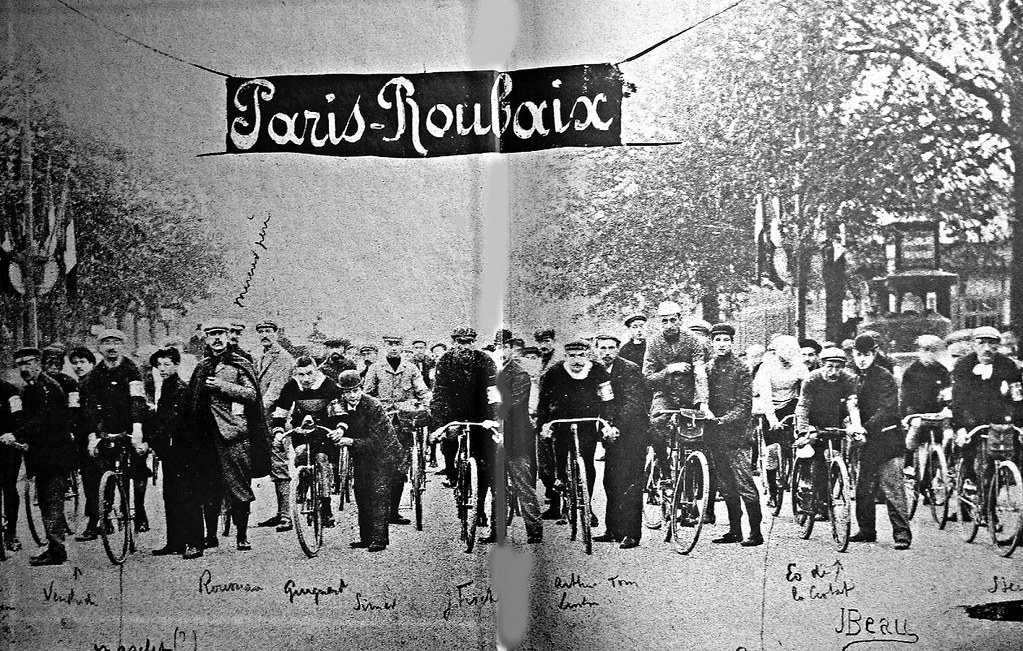The Paris Roubaix cycling race, also known as The Hell of the North, is a beautiful race over poor cobblestone roads that is highly regarded by many cycling enthusiasts and provides a spectacle every year.
Just as the Ronde Van Vlaanderen is a popular festival for the Flemish people and the highlight of the cycling season, Paris Roubaix is the most important cycling classic for the French. By the way, Paris Roubaix will be ridden a week after the Tour of Flanders.

Below you will find some facts and anecdotes about the Helle Classic.
Origin of Paris Roubaix
The first edition of Paris Roubaix was organized in 1896 by the newspaper Le Vélo at the request of two French entrepreneurs who had built a cycling track in Roubaix and could thus generate extra publicity.
Following the example of Bordeaux Paris, a race with start in Paris and finish on the vélodrome André Pétrieux of Bourdaix was organized. The start of a piece of legendary cycling history. The first edition was won by the German Josef Fischer.
Since 1968, the starting point is no longer in Paris but in Compiègne, 80 km north of the capital.
However, the name Hel van het Noorden does not refer to the poor state of the roads, but originated in 1919 when a journalist followed the race along the severely devastated landscape of northern France as a result of the 1st World War.
1 of the 5 monuments: together with the Tour of Flanders, Liège Bastogne Liège, Milan Sanremo and the Tour of Lombardy, Paris Roubaix is part of the 5 monuments.
more than 50km of cobblestones: in total there are about 55 km of cobblestones, divided over 30 strips, in the course. If you know that the total race is 259 km long, this is about 20%. Each strip has a gradation in stars, the more stars (maximum 5) the more difficult and worse the strip. The first strip has number 30 and the last one has number 1.
Forest of Wallers – Arenberg and Carrefour de l'Arbre: these are the 2 most difficult cobblestone sections of the race, both are over 2km long and have the maximum of 5 stars (the more stars the more difficult). The cobblestones are really terrible with gaps of a few centimeters in between.
These 2 strips usually cause a shift in the peloton. If you are broken here, you must irrevocably let the peloton drive.
Winning in the world champion's jersey: this honor was reserved for Marcel Kint (1943), Rik Van Looy (1961 and 1962), Eddy Merckx (1968), Francesco Moser (1978), Bernard Hinault (1981) and Peter Sagan (2018).
The double: many riders make it a prestige to win the double Tour of Flanders and Paris Roubaix. Because both races are ridden in 1 week, this is possible if a rider is in top form. The riders who succeeded were:
- Heinrich Suter in 1923
- Romain Gyssels in 1932
- Gaston Rebry in 1934
- Raymond Impanis in 1954
- Fred De Bruyne in 1957
- Rik Van Looy in 1962
- Roger De Vlaeminck in 1977
- Peter Van Petegem in 2003
- Tom Boonen in 2005 en 2012
- Fabian Cancellara in 2010 en 2013
As you can see, no Eddy Merckx, one of the few times that the cannibal is missing from a list.
4 victories: only 2 riders managed to win Paris Roubaix 4 times, namely Roger De Vlaeminck also called Monsieur Paris Roubaix and Tom Boonen, the Bom van Balen.
57 victories: Belgium is still the leader, followed by France with 28 victories.
In 1976, the wonderful documentary A Sunday in Hell was made about this mythical competition by the Danish director Jørgen Leth in which you are, as it were, dragged into the competition.



